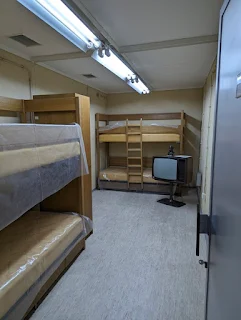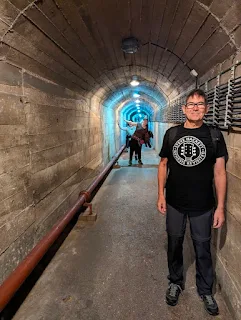A couple of hours south-west of Sarajevo is the town of Mostar. This is our excursion for the day. Immediately after breakfast we boarded our bus for the journey there. Out of Sarajevo we were greeted by a new freeway which made the first part of the drive very easy and quick. Numerous very long tunnels took us straight through the surrounding mountains rather than around them, which would have made for a very long day.

 When
the freeway inevitably ended we were back on the normal “state
highway”, as it were. In
the town of Konjic, on the Neretva river, we stopped at a
roadside cafe gave us the chance to stretch the legs, powder the nose
and get a caffeine fix.
When
the freeway inevitably ended we were back on the normal “state
highway”, as it were. In
the town of Konjic, on the Neretva river, we stopped at a
roadside cafe gave us the chance to stretch the legs, powder the nose
and get a caffeine fix.
Just a few blocks away from the coffee stop we turned off the main road down a small lane which came to a dead end where three non-descript, white, two-storey houses were sitting right up against a sheer rock-face. Each of the houses were just a front for entrances into an elaborate network of tunnels and rooms big and small which served as the nuclear fallout shelter of the Yugoslavia dictator Marshall Josef Tito. Tito, the self-declared “President for Life” built this facility largely with American money, money that was meant to go to the Yugoslav people as aid to help them recover from WWII. Costing US$4 billion to build over 27 years and finally completed in 1979, less than a year before Tito’s death, in 2024 monetary terms it would cost US$40 billion – and opposition political parties complain all too readily these days about the cost of building a tunnel or two to facilitate a better transport network for the future. Tito’s bunker extends 250m into the mountain and, at its deepest point is 280m below ground. Everything you can imagine to sustain the lives of Tito and 350 of his closest friends for six months is under the ground – power generators, telecommunications, huge diesel tanks, water storage reservoirs, sleeping quarters, conference rooms and the list goes on and on. Of course, the bunker was never used but was maintained for a number of years. None of it was ever upgraded so as a nuclear shelter it’s completely useless. It’s actually quite a time capsule of the 60’s and 70’s. It doubles as a contemporary art gallery, which is kind of in keeping with the weirdness of the place.
The construction of the facility was a closely guarded secret. It was being built right under the noses of the people of the nearby town (for 27 years) and they didn’t know, helped a little by the fact that a military munitions factory was located nearby. Not until 2000 did its existence became public knowledge. Of course the Americans knew where the “aid money” was going but turned a blind eye hoping to curry favour with Tito who, although a Communist, had a very poor relationship with the Soviet Union – which was just the way the Yanks liked it.

 For lunch we stopped at cafe on the highway that sold Borek - a local dish of rolled, flaky pastry filled with meat, spinach or cheese - sort a like the Greek Spanikopita. From
here we travelled another hour or so to the town of Mostar.
For lunch we stopped at cafe on the highway that sold Borek - a local dish of rolled, flaky pastry filled with meat, spinach or cheese - sort a like the Greek Spanikopita. From
here we travelled another hour or so to the town of Mostar.  A much
bigger town than I has imagined – a city, really. All the tourist
flock to the old town, as we did, and the famous bridge across the
Neretva river. This is the bridge where the young men of the city
launch themselves from the top of the bridge
into the freezing cold waters of
the river some
20m
below. The day was quite hot by the time we arrived mid-afternoon so
it was shorts and tee-shirt weather only. A big crowd made its way
down to the bridge past countless stalls selling the usual crappy
souvenirs, bars, restaurants and ice-cream vendors. The bridge was
crowded and uncomfortably close. Some young chaps jumped when they’d
relieved a sufficient number of tourists of their hard-earned. The
bridge is very difficult to walk upon as are the streets leading to
it with the former being quite steep and made of what looked like
marble blocks and the later being laid with smooth round river rocks.
Both were polished and very slippery due to the millions of tourist
feet at have walked them for a long time.
A much
bigger town than I has imagined – a city, really. All the tourist
flock to the old town, as we did, and the famous bridge across the
Neretva river. This is the bridge where the young men of the city
launch themselves from the top of the bridge
into the freezing cold waters of
the river some
20m
below. The day was quite hot by the time we arrived mid-afternoon so
it was shorts and tee-shirt weather only. A big crowd made its way
down to the bridge past countless stalls selling the usual crappy
souvenirs, bars, restaurants and ice-cream vendors. The bridge was
crowded and uncomfortably close. Some young chaps jumped when they’d
relieved a sufficient number of tourists of their hard-earned. The
bridge is very difficult to walk upon as are the streets leading to
it with the former being quite steep and made of what looked like
marble blocks and the later being laid with smooth round river rocks.
Both were polished and very slippery due to the millions of tourist
feet at have walked them for a long time.
The group watched a Bosnian coffee making ceremony which was not particularly exciting or interesting then went it’s separate ways. Some of the girls and Dennis went to brave the freezing waters of the river for a swim at a little beach while Kerry and I killed a couple of hours browsing in shops, drinking coffee and eating ice-cream. At one of those stops I managed to get a second postcard off to Mum. By 6:00pm all the “lost sheep” had come home and we started the 2-hour journey back to Sarajevo.














Interesting and pretty part of the world. You are showing why almost any part of the world that one doesn't know much about is worth visiting, discovering little gems and learning some world history.
ReplyDeleteVery fascinating info about Tito's tunnels
ReplyDelete